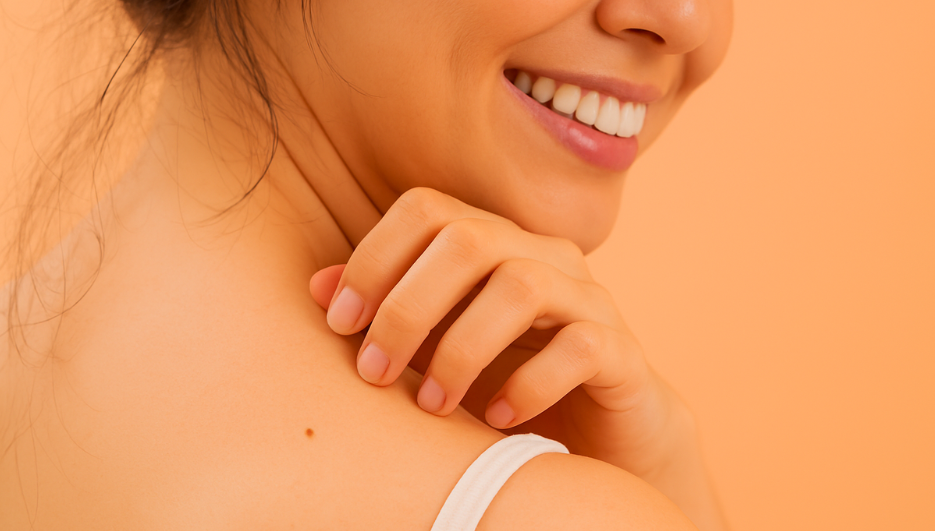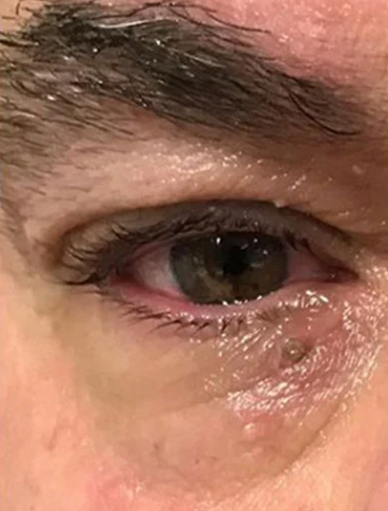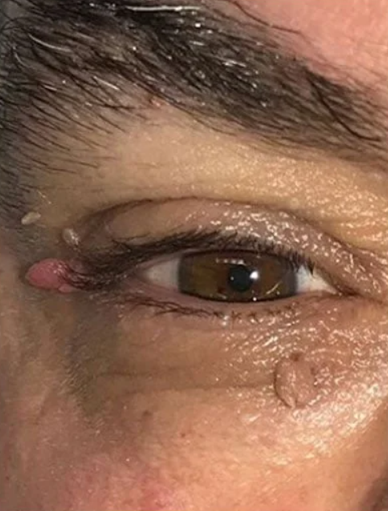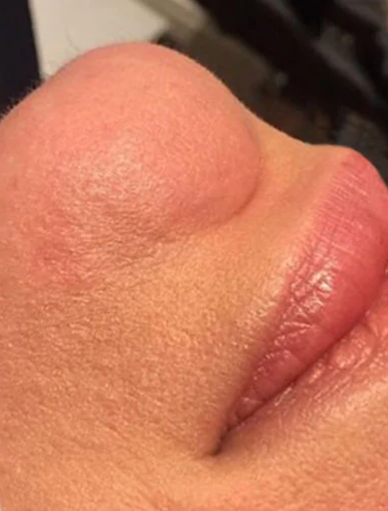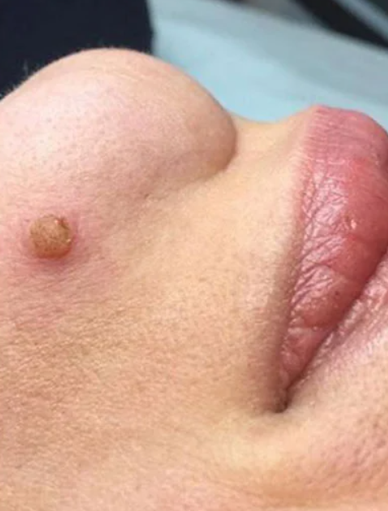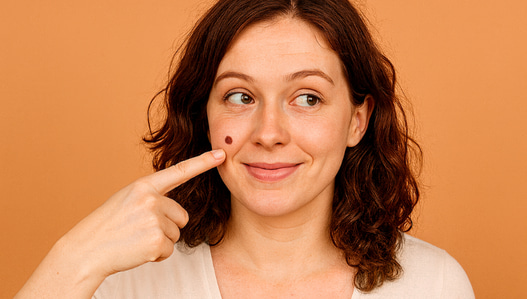Summary:
- Picking a mole does not cause cancer, but bleeding, scarring, and infection can occur.
- Removing non-cancerous moles using sterile tools can be a safe option.
- When monitoring your moles, always keep the ABCDE rules.
- Consult a dermatologist instead of doing it on your own.
Mole: What is it?
A mole is a common type of skin growth that has a different shape, size, and colour. Some people develop moles gradually over time, while others are naturally born with them. In most cases, moles are harmless and just a usual part of our skin. However, changes in moles could be a sign of a more serious condition that you should not ignore, like melanoma (a form of skin cancer).
Different Kinds of Moles
Moles can look different from one another. Most of them are harmless, but some may need to be monitored because they might be a sign of skin cancer.
Having moles is normal, almost every adults have them.
Common Moles:
These are the usual non-cancerous, round or oval-shaped moles that most individuals have (10 to 40 of these types). These usually occur in places that are most exposed to the sun.
- Small, about 6mm or less in diameter
- Round or oval shape
- Smooth surface with distinct edges
- Even colouring
Atypical Moles (Dysplastic Nevi):
Appearing in the most exposed area, and even those covered ones, like the chest or waist. This kind can develop into cancer.
- Larger than 0.25-inch in diameter
- A mix of colours (tan, brown, pink, or black)
- Flat appearance with uneven or blurred edges
- Can be smooth, flaky, or slightly bumpy
These are moles you’re born with, although some may appear after birth. While most of them are harmless, larger ones have the risk of developing into skin cancer later in life.
- Have different sizes
- Varies in shape and colours
- May grow in time
- Small or medium usually carry a very low risk
- Large/giant moles have a higher risk of skin cancer
When to worry
It is a good idea to keep an eye on your mole over time, even if most of them are completely harmless. The key to detecting skin cancer like melanoma at its most treatable stage is regular self-checking.
The ABCDE rule is a simple way to remember what to look for:
- A-Assymetry: One side of your mole doesn’t match the other.
- B-Boarder: Edges are irregular, blurred, or jagged instead of smooth.
- C-Colour: The mole has multiple colours or uneven shades.
- D-Diameter: It’s larger than 6mm
- E-Evolving: It changes its appearance (size, shape, colour, or texture).
The Danger of Picking a Mole
Most of us have moles on our skin; it’s normal and considered to be harmless. But sometimes it can make us feel uncomfortable when it becomes irritated because of our clothing and jewellery, or even because of our hair strands. Those that are located on the face can sometimes draw attention, which makes us conscious. Some of us really want to scratch them and have them removed permanently. Doing this on our own can bring us to more serious problems.
If you pick a mole, what will happen?
A chance of getting inflamed or irritated will occur when you suddenly scratch or pick your mole.
Here’s what will happen:
- Bleeding: This is the result when you accidentally remove your mole because it can injure the surrounding skin.
- Inflammation: Using your hands when picking your mole can make it red and swollen.
- Infection: Open wounds can let bacteria enter your skin and may become infected.
- Scarring: Improper picking can create wounds that lead to scarring.
It can make it hard to see the warning signs if you choose to remove your moles on your own. Let your dermatologist check on your moles, particularly those that are itchy or bleeding, or if you think the appearance is not normal. This will ensure that you will undergo a proper assessment and have the chance to know the cancerous one.
Can you do safe picking?
Doing a DIY to pick your moles is surely not safe. Infections and complications may arise from this. And in case you scratched off your moles accidentally, make sure to wash them right after; if there’s bleeding, stop them by gently pressing the area using a tissue.
Aside from the first aid, you may also need to do the following:
- Apply antibiotic ointment to reduce the infection.
- Cover your wound using a bandage for protection.
- Do not touch the wound or pick the scars.
- If the wound takes time to heal and there are possible signs of infection, consult your doctor right away.
Consequences
Picking moles may lead to cancer – that’s what other people believed. But it’s not true, the truth is that you may not know if the mole is cancerous when you pick them and don’t let your doctor see it. It may also lead to infection and scarring.
When is the right time to pick?
It’s generally not recommended to remove your mole and pick it at your own. If you do it, the risk will tend to develop. Although there are some considerations that can allow the removal, like if the mole is benign, or if things like clothing and jewellery cause irritation, then you may safely remove your moles, but you need to follow some safety precautions. Monitor the area and visit your doctor if it still makes you uncomfortable.
Definitely, the right thing to do is to go to a reputable clinic and let the skin experts do the removal.
Safely picking a mole: proper techniques
If going to the doctor is not really a priority for you at this time, we can give you some ways on how to remove your moles in a safe manner. Removal is only applicable to those non-cancerous types.
Here’s what you can do:
- Gentle cleansing: Mild soap and lukewarm water – use them to clean the area together with your hands.
- Sterile tools: Disinfect your equipment before using it.
- Avoid DIY surgery: Do not pick a flat mole or a cancerous one.
- Consult your doctor: To make the removal safe, consider going to your trusted clinic.
Effective & professional doctor-led Mole at our central London clinic
Verified Before & After
Verified Before & After
Signs You Should Avoid Picking a Mole
The moles that we have on our bodies are typically harmless, but some of them may be a sign of skin cancer. The signs you should watch are:
- Continous bleeding
- Changes of appearance (size, colour, or shape)
- Becomes itchy or painful
- There’s an open sore or flakiness
Is picking a mole bad for your health?
Repeatedly picking your mole can be bad for your health. Most of the time, it may lead to infection and delayed healing of your wounds, which may cause scarring to your skin. An opportunity to detect the serious risk of skin cancer can be missed as well. Proper removal can greatly help you have good, healthy skin and can prevent future problems when assessed.
Can picking a mole cause cancer?
As we have discussed previously, cancer is not the result of picking up the moles. The truth is, picking them will eventually lead to skin irritation and infection, as well as a missed diagnosis of cancerous cells. What you need to do in order to prevent these things from happening is to consult your doctor.
Conclusion
- Infection and scarring may occur if you do the picking of your moles, so you have to avoid it. Also, some warning signs of skin cancer may not be detected.
- Keep an eye on your moles. Check for any changes in sizes, shape, colour, or borders.
You may need to see your dermatologist if you notice that your mole is:
- Bleeding or painful
- Changing its appearance
- Have different features from the other moles (ugly duckling sign).
FAQs
- Can cancer be the cause of picking the moles?
Cancer will not develop when you pick a mole, but it is possible that you will not detect the warning signs when it becomes damaged.
- How to determine if picking a mole is safe?
Benign and raised moles are the ones that are safe to pick, plus if it is not changing their appearance.
- Is there a safe way to pick a mole?
Things to consider are the cleanliness of your hands and the mole area. Wash them with soap and water, and sterilise the tools that you need to use. Once you have removed it successfully, cover it with a bandage and keep an eye on it.
- When to consult a dermatologist?
A bleeding or painful mole should be evaluated, or one that changes its appearance and shows the symptoms of ABCDE.
- Does a mole grow back after you pick it?
You can only pick a mole at its surface level. So there’s a possibility that it will grow back. Monitor the area and have it seen by your doctor.
Reserve a mole appointment
One of our experts will be more than happy to answer any questions you have.
Book AppointmentNafalya Francis
★★★★★
I had a fantastic experience with dr Omar. His explanation into mole removal really put me at ease to go ahead with the procedure! I would recommend this clinic
16th April 2025
Hayley Dixon
★★★★★
Great pain free experience for a mole removal - would recommend
2nd July 2025
D Scott
★★★★★
I had a white mole removed by Mr Tee and it was a very easy and pleasant experience from start to finish - look forward to seeing the result!
21st May 2025



